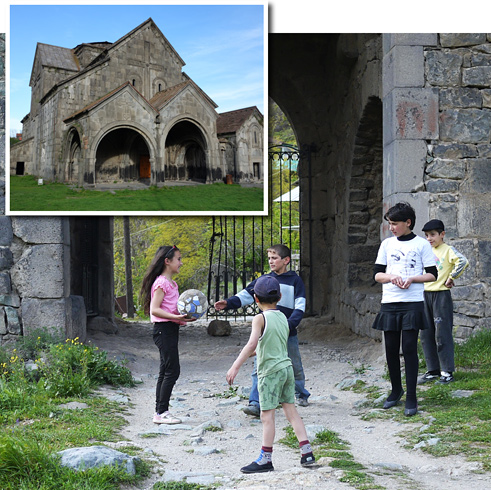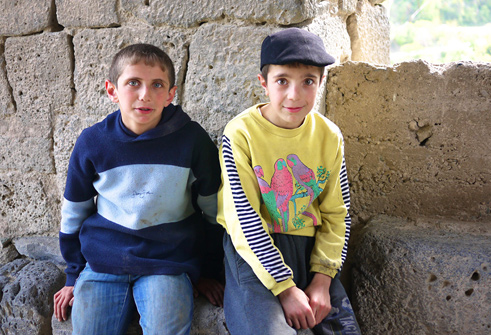TOXIC POLLUTION CLEANUP IN ARMENIA
In 23 Armenian communities, up to 85% of young children are at risk of lead poisoning. That means thousands of kids are at risk for mental disabilities and developmental delays, decreased bone and muscle growth, as well as damage to the nervous system, kidneys and hearing. The good news is that there is a cost-effective solution to this environmental and public health disaster: clean up the lead and educate and treat those affected.
The health of Armenian children is an important issue for Armenia Fund USA.
We’ve developed a partnership with the global non-profit Pure Earth to tackle the lead contamination poisoning Armenian children and create a healthy future for them. Since its establishment in 1999, Pure Earth has cleaned up more than 90 toxic sites in poor communities across the globe, impacting over 4 million lives. In addition, Pure Earth created and maintains the world’s largest database of toxic sites, critical to prioritizing its future remediations and informing governments about the toxic hot spots poisoning their citizens.
|
 |
The soil lead concentrations around Pghindzavank (Coppermine Monastery) have been documented at more than 100 times the U.S. safety standard. |
In 2012, Pure Earth conducted the first independent, comprehensive assessment of toxic pollution in Armenia. This program identified 23 contaminated sites that threaten the health of Armenians. It also identified the main pathways through which people, especially children, are exposed to contamination, including current and abandoned mines and unsafe lead acid battery recycling practiced by local residents which are contributing to the spread of the lead dust among Armenian communities.
A plan was developed to mitigate the health impacts of toxic pollution in Armenia over the next five years. The goal is to reduce health risks, especially the risk of lead poisoning, resulting from the mining waste and lead acid battery recycling.
The first stage of the plan is addressing the most toxic site in Armenia, the land surrounding the Armenian Apostolic Church in Akhtala in Marz Lori, 185 kilometers (115 mi) north of Yerevan. The site is the area of Armenian Apostolic Church monastery, so called Pghindzavank (meaning Coppermine Monastery)—a historic, community site where families picnic and children visit on school trips. The monastery was built on the area of 10th century fortress and copper mine. The mining was active through 13th century. The main church was built at the end of the 12th century and rebuilt in the 13th and 18th centuries. The monastery yard still contains contamination from former mining activities.
 |
 |
Pghindzavank (meaning Coppermine Monastery)—a historic, community site where families picnic and children visit on school trips. |
The soil lead concentrations have been documented at up to 47,000 mg/kg more than 100 times the U.S. cleanup standard of 400 mg/kg. “More significantly, 84% of approximately 500 children in Akhtala are at risk of lead poisoning,” said Dr. Varduhi Petrosyan, Dean of the School of Public Health at American University of Armenia.
 |
 |
«84% of approximately 500 children in Akhtala are at risk of lead poisoning» |
To clean land surrounding the Armenian Apostolic Church in Akhtala the following will be necessary:
- Remediation of the churchyard:
- Train local engineers in the cleanup process
- Place a barrier to mark the contaminated soil
- Lay down clay and then clean soil
- Finally plant grass atop the clean soil
- Health and Education Interventions:
- Up to 300 children will be tested for blood lead concentrations
- Those with elevated levels will be treated, and counseling will be provided to families
- Community educational workshops will be held on the dangers of lead poisoning
After successful completion of Akhtala project, the remediation of lead, arsenic and cadmium could be conducted at other highly toxic sites of Armenia including:
- Armanis gold-polymetallic mine. Located in the Armanis community of Stepanavan, processed raw material is being transported via trucks and abandoned in Dzoraget. There are deposits of waste along the roadsides and in the schoolyard that need to be cleaned up. Food supplies are likely being impacted, and residents can be poisoned when swimming in the river.
- Alaverdi smelter and Madan abandoned tailings (waste from a nearby mine). The city of Alaverdi is being polluted by two sources: smoke from the smelter which is located in the city, and a nearby tailing pond in Madan. A cleanup plan needs to be developed and implemented in partnership with local stakeholders.
- Kapan Geghanush tailings. A tailing pond located 50–100 meters away from the outskirt of Kapan (Yerkatughayinner alley) is contaminating nearby homes, and remediation is needed. In addition the village of Geghanush is also adjacent to the tailing pond (approximately 2 km away) and is at risk.
- Yerevan Lead Acid Battery Recycling sites. Based on interviews and the results of lead blood level testing, Pure Earth has determined that there is lead contamination in the residential areas of Yerevan due to informal lead acid battery recycling, requiring community education and training, remediation and treatment for the children impacted.
You can Donate online now for the Toxic Pollution Cleanup Project.
|





